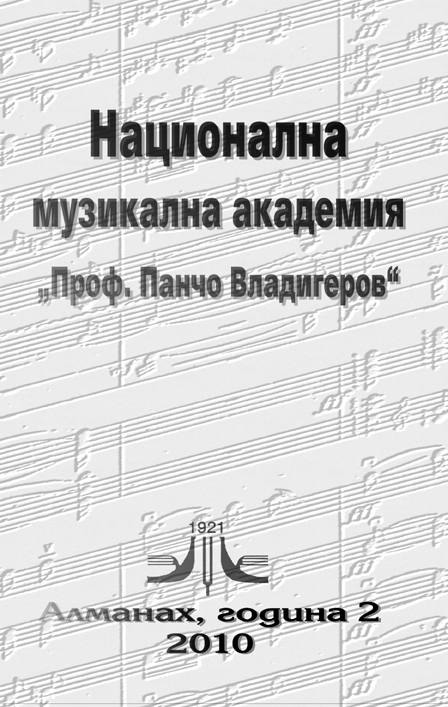Художествената образност в пиесите от клавирния цикъл „Мъниста“ на Красимир Тасков. Някои характерни интерпретационни особености, почерпени от непосредствен педагогически опит
The artistic imagery in the pieces of Krassimir Taskov’s “Beads” piano cycle. Some essential interpretational special features, gained via close observational pedagogic experience
Author(s): Alexander VassilenkoSubject(s): Fine Arts / Performing Arts, Music
Published by: Издателство НМА „Проф. Панчо Владигеров”
Keywords: Krassimir Taskov; Piano Pieces; “Beads” Piano Cycle; Pedagogic Experience
Summary/Abstract: Krassimir Taskov’s 12-piece “Beads” piano cycle was originally planned, composed and finished in close artistic interconnection with the piano performer Dimiter Tzanev in 2004 – 2005. It was dedicated to him. The composition was based on personal inspirations of Dimiter Tzanev and he was the first to perform it on the 2005 “Pianissimo” and “New Bulgarian Music” Festivals. The reason for my observations was my recital performance (including works by Taskov), featuring Assya Vassilenko, as well as six of my pupils from the National School of Music, that played the pieces from the stated cycle. The piano works by Taskov are numerous and diverse in genre and forms used: it is due to his strenuous recital activity as solo piano performer and chamber musician. Focusing attention on the “Beads” cycle, I would like to share my belief that, in general, he projects basic distinctive traces of Taskov’s piano works. First of all, it is true because of the inherent interest of the composer towards the miniature. Perhaps this is due to the intensified sensitivity of the author, the strive for concentrated expression of transitory state, image, experience and mood. Groupings of similar miniatures in a cycle can be found quite often in Krassimir Taskov’s works. Secondly, another important circumstance is: despite the function of the twelve pieces that were meant to be performed by growing up piano players, the author never goes down the “trite” road of seeking an approachable “childish” language – a means of a more rudimentary imagery, trivial diatonic, traditional harmonic structure and simplified general fabric. Those pieces need a longer period of rationalization and lie far away from the inherent banality of the messages, typical for works with the same purpose, as is with other composers. In other words, Taskov remains true to his creative manner: he converses with the hypothetically not so mature and inexperienced performer as his equal and strives to make him supportive to the sophisticated contemporary music matter directly and uncompromisingly, without “buffer zones” and “adapted versions”. In the pieces of the “Beads” cycle could be found many of the well known intonations and compositional and piano techniques that are inherent to other of his works. The structure in most cases is complex, the harmonic language is contemporary, with modal diversity and widely used dissonant interval juxtapositions and progressions. There are present frequent rhythmical relation changes. The melody, in the traditional sense, is almost entirely absent. Sometimes we could find aleatoric type music text and signs of a serial compositional technique. There could be seen often emphatically-contrastive dynamic progressions and multiple diverse accents, which, in an unexpected manner, “cut through” the development of the structure and bring high tension, pictorial coloring and distinctiveness of the genre. With all their technical complexity and emotional intensity, the pieces are comfortable to perform. This comes naturally from the fact that Krassimir Taskov himself is an experienced piano performer and a teacher that knows the problems of the professional piano performer to the smallest detail. About the idea, implied in the concert performance: I thought it was especially interesting to hear the interpretations of the young future professionals that haven’t yet reached their artistic identity. The messages implied in the pieces were addressed to them: I felt like I wanted to know and understand their answer, their artistic and personal reaction. I’ve been observing with great interest the young piano performers getting acquainted with the contemporary music language – a zone that offers great basis for “unjaming” of the fantasy, improvisation and interpretational coauthoring. I am convinced that such an acquaintance should be made as early as possible, because it offers a new view of life to the growing up musician and future colleague. The effort definitely leads to a great result. I believe that it is extremely important to propagate the Bulgarian author’s contribution to the so called “classical music” field, especially in the situation of growing globalization. I will not discuss in detail many of the talented works by Bulgarian composers from different generations, that were created for developing piano players – a great number of them are undeservedly forgotten. However, if this is due to generation changes, the present-day aesthetics with its inherent topical reality, then we should commit in a more responsible way to the contemporary authors. Krassimir Taskov joins the first ranks among the composers that thanks to their bright individual and professional style, deserve special attention. In brief, I will allow myself to formulate my opinion in the following manner: When we get to know “Beads”, we meet a worthy and original model of short piano pieces for pupils in relatively advanced phase of education, that aims to evoke the fantasy and the skills of a performer to a rather high artistic level. Of course, it is necessary to point out that including those pieces in the repertory of students studying piano as a obligatory subject (as well as a major subject), is absolutely appropriate and has already been put widely into practice.
Journal: Алманах - Национална музикална академия „Проф. Панчо Владигеров“
- Issue Year: 2011
- Issue No: 2
- Page Range: 80-94
- Page Count: 15
- Language: Bulgarian

